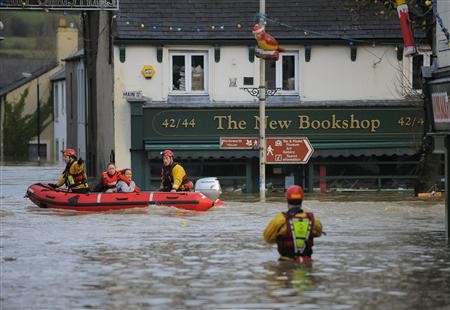A bunch of illegally hacked UK e-mails storm the anti-scientific side of the blogosphere at the same time as an uber-extreme weather event hits Britain. I guess when it rains, it pours — literally:
Environment Secretary Hilary Benn told the BBC that flood defenses were meant to withstand a one-in-100-years flood — but could not cope with the volume of water.
“What we dealt with last night was probably more like one-in-a-1,000, so even the very best defenses, if you have such quantities of rain in such a short space of time, can be over-topped,” Benn said.
Britain’s Meteorological Office added that the amount of rain expected for all of November had fallen in one day.
Local House of Commons lawmaker Tony Cunningham said the flood was “of biblical proportions.” That’s why CP calls it Hell and High Water. The headline quote was from the Times Online story. Here’s the UK Independent:
Statistics compiled by MeteoGroup, the weather division of the Press Association, show the deluge is the greatest seen since meteorologists started using instruments to record rainfall – back in 1727.
None of those stories make the climate change link, though two years ago, after flooding almost as rec0rd-breaking, PM Gordon Brown said, “Obviously like every advanced industrial country we’re coming to terms with some of the issues surrounding climate change…. This has been, if you like, a one in 150 years set of incidents that has taken place in both Yorkshire and Humberside and now in Gloucestershire and the Severn.” Sadly, 1-in-150 year deluges — or 1-in-1000 — just aren’t what they used to be. Environment Secretary Hilary Benn went further back then, noting that “the scientific consensus was that the climate was changing,†and adding, “The world is going to have to come to terms, so the scientists are telling us, with more extreme weather events and that’s why we need to anticipate them and try and plan for them.”
Significantly, climate science actually predicts that, increasingly, the old age is right:Â When it rains, it pours.
I have called this type of rapid deluge, “global warming type†record rainfall, since it is one of the most basic predictions of global warming science — and it’s an impact that has already been documented to have started. For completeness’ sake on the subject, I’ll run through some of the literature. Regular readers can skip the rest of this post. You can find more at “Hell and High Water hits Georgia,” and there’s some terrific technical meteorological analysis at “Weather Channel expert on Georgia’s record-smashing global-warming-type deluge.”
In 2004, the Journal of Hydrometeorology published an analysis by NOAA’s National Climatic Data Center that found “Over the contiguous United States, precipitation, temperature, streamflow, and heavy and very heavy precipitation have increased during the twentieth century.â€
They found (here) that over the course of the 20th century, the “Cold season (October through April),†saw a 16% increase in “heavy†precipitation events (roughly greater than 2 inches [when it comes as rain] in one day), and a 25% increase in “very heavy†precipitation events (roughly greater than 4 inches in one day)– and a 36% rise in “extreme†precipitation events (those in the 99.9% percentile — 1 in 1000 events). This rise in extreme precipitation is precisely what is predicted by global warming models in the scientific literature.
In fact, the last few decades have seen rising extreme precipitation over the United States in the historical record, according to NCDC’s Climate Extremes Index (CEI):
No surprise, then, that as a recent WWF post noted, U.S. Sees Wettest October on Record; Arkansas Records are Washed Away.
Even the Bush Administration in its must-read U.S. Climate Change Science Program report, Weather and Climate Extremes in a Changing Climate, acknowledged:
Many extremes and their associated impacts are now changing…. H
eavy downpours have become more frequent and intense….It is well established through formal attribution studies that the global warming of the past 50 years is due primarily to human-induced increases in heat-trapping gases.… The increase in heavy precipitation events is associated with an increase in water vapor, and the latter has been attributed to human-induced warming.
In the future, with continued global warming, heat waves and heavy downpours are very likely to further increase in frequency and intensity. Substantial areas of North America are likely to have more frequent droughts of greater severity.
In short, get used to it.
And let’s end with a NYT quote about record-breaking extreme weather in Australia earlier this year from someone’s whose emails are now, ironically enough, in the news:
The flooding in the northeast and the combustible conditions in the south were consistent with what is forecast as a result of recent shifts in climate patterns linked to rising concentrations of greenhouse gases, said Kevin Trenberth, a scientist at the United States National Center for Atmospheric Research.


